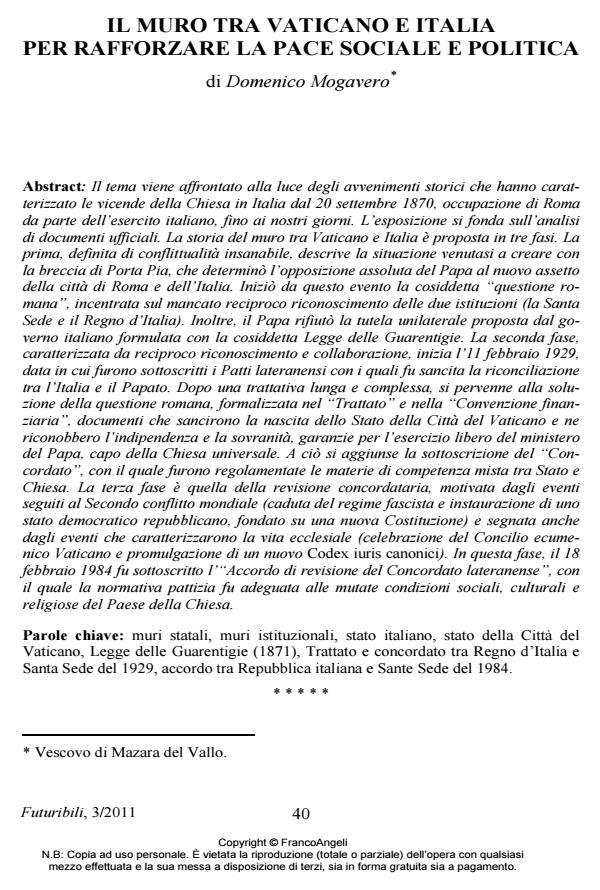The wall between the Vatican and Italy to strengthen the social and political peace
Journal title FUTURIBILI
Author/s Domenico Mogavero
Publishing Year 2012 Issue 2011/3
Language Italian Pages 42 P. 40-81 File size 343 KB
DOI 10.3280/FU2011-003004
DOI is like a bar code for intellectual property: to have more infomation
click here
Below, you can see the article first page
If you want to buy this article in PDF format, you can do it, following the instructions to buy download credits

FrancoAngeli is member of Publishers International Linking Association, Inc (PILA), a not-for-profit association which run the CrossRef service enabling links to and from online scholarly content.
The topic is addressed in the light of the historical events that have marked the history of the Church in Italy from September 20, 1870, occupation of Rome by the Italian army, to this day. The article is based on analysis of official documents. The history of the wall between the Vatican and Italy comes in three phases. The first, called the irreconcilable conflict, describes the situation created by the breach of Porta Pia, which determined the absolute opposition of the Pope to the new structure of the city of Rome and Italy. It started this event called "Roman Question", which focuses on mutual non-recognition of the two institutions (the Holy See and the Kingdom of Italy). Moreover, the Pope refused the protection given by the Italian government unilaterally formulated with the so-called Guarantee-Act. The second phase, characterized by mutual recognition and cooperation, begins February 11, 1929, when the Lateran Pacts were signed by which the reconciliation was sealed between Italy and the Papacy. After a long and complex negotiations, it came to solving the Roman question, formalized in the "Treaty" and "Financial Agreement" documents that sanctioned the establishment of the State of Vatican City, and they recognized the independence and sovereignty, guarantees for the free exercise of the ministry of the Pope, head of the universal Church. To this was added the signing of the "Concordat", which were regulated with the matters of mixed competence between State and Church. The third step is to review the Concordat, motivated by the events that followed the Second World War (the fall of the Fascist regime and the establishment of a democratic republican state, founded on a new constitution), and also marked by events that characterized the life of the Church (celebration of the Second Vatican Ecumenical Council and promulgation of a new Codex iuris canonical). In this phase, 18 February 1984 was signed’s "revision of the Lateran Concordat of Agreement", with which the covenantal law was adequate to the changing social, cultural and religious in the country of the Church.
Keywords: Muri statali, muri istituzionali, stato italiano, stato della Città del Vaticano, Legge delle Guarentigie (1871), Trattato e concordato tra Regno d’Italia e Santa Sede del 1929, accordo tra Repubblica italiana e Sante Sede del 1984.
Domenico Mogavero, Il muro tra Vaticano e Italia per rafforzare la pace sociale e politica in "FUTURIBILI" 3/2011, pp 40-81, DOI: 10.3280/FU2011-003004